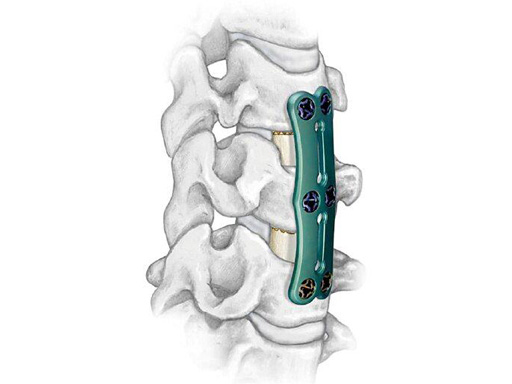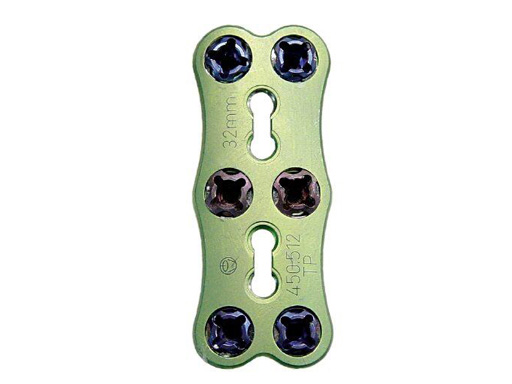
Anterior Cervical Compression System (ACCS)
In the recent past, the anterior cervical plating market has been divided over the issue of semi-constrained systemswhether a semi-constrained system with its assumed benefits is better than one that is constrained. Studies seem to indicate that multilevel constructs may have lesser pseudoarthrosis and non-fusion rates when screws allow an angular rotation. A key factor to consider when creating an improved anterior cervical system is that semi-constrained systems do not compromise on the sufficiently open neural foramen which was created to achieve decompression.
In tests for load sharing of plateswith a full-length graftconstrained plates transmitted 95% of the axial load to the graft, indicating that a locked construct effectively shares load. However, when the graft was shortened by 10%, they did not share any load until 90 N were applied, and at 120 N, it shared only 17% of the load. In multilevel cervical corpectomies, clinical experience seems to indicate that anterior plating does not prevent construct failure. It is conjectured that the plate design may contribute to this. A semi-constrained construct does not significantly change strut-graft loads in extension or flexion. Thus it may be biomechanically advantageous to use these for such indications.
The Anterior Cervical Compression System for anterior cervical discectomy and fusion is indicated for anterior screw fixation to the cervical spine (C2C7) for the following indications: degenerative disc disease (DDD), spondylolisthesis, spinal stenosis, and tumors (primary and metastatic), failed previous fusions, pseudoarthrosis, and deformity (defined as kyphosis, lordosis and scoliosis).
The Anterior Cervical Compression System (ACCS) consists of plates with cortex and cancellous bone screws. The plate attaches to the anterior portion of the vertebral body of the cervical spine (levels C2C7). The system uses prelordosed plates that are designed to follow the anatomy of the cervical spine.
Additional features of the Anterior Cervical Compression System:
- Allow the creation of a rigid construct.
- Allow angular settling of the screw with respect to the plate as an alternative to the fully rigid construct.
- Anatomical alignment-therefore prelordosed.
- Low profile and footprint-2.0 mm thick and 16 mm wide.
- Quick reconstruction-therefore one-step locking screw-plate interface.
- Variable angulation-up to 12 cephalad and caudal angles to enable ease of screw insertion with anatomical alignment.
- Fixed angle screws (at 4 only-cephalad and caudal) to build a rigid or a hybrid construct.
- Graft visualization through dogbone feature.
- The screw will enable self-retention and a higher yield torque.
- Wider range of screws (cortex and cancellous) with additionally available screw lengths and respective drill lengths.
- Simple and few instruments.
- Simpler and more intuitive graphic case for the OR personnel.
Hazards and labeling
Due to varying countries’ legal and regulatory approval requirements, consult the appropriate local product labeling for approved intended use of the products described on this website. All devices on this website are approved by the AO Technical Commission. For logistical reasons, these devices may not be available in all countries worldwide at the date of publication.
Legal restrictions
This work was produced by AO Foundation, Switzerland. All rights reserved by AO Foundation. This publication, including all parts thereof, is legally protected by copyright.
Any use, exploitation or commercialization outside the narrow limits set forth by copyright legislation and the restrictions on use laid out below, without the publisher‘s consent, is illegal and liable to prosecution. This applies in particular to photostat reproduction, copying, scanning or duplication of any kind, translation, preparation of microfilms, electronic data processing, and storage such as making this publication available on Intranet or Internet.
Some of the products, names, instruments, treatments, logos, designs, etc referred to in this publication are also protected by patents, trademarks or by other intellectual property protection laws (eg, “AO” and the AO logo are subject to trademark applications/registrations) even though specific reference to this fact is not always made in the text. Therefore, the appearance of a name, instrument, etc without designation as proprietary is not to be construed as a representation by the publisher that it is in the public domain.
Restrictions on use: The rightful owner of an authorized copy of this work may use it for educational and research purposes only. Single images or illustrations may be copied for research or educational purposes only. The images or illustrations may not be altered in any way and need to carry the following statement of origin “Copyright by AO Foundation, Switzerland”.
Check www.aofoundation.org/disclaimer for more information.
If you have any comments or questions on the articles or the new devices, please do not hesitate to contact us.
“approved by AO Technical Commission” and “approved by AO”
The brands and labels “approved by AO Technical Commission” and “approved by AO”, particularly "AO" and the AO logo, are AO Foundation's intellectual property and subject to trademark applications and registrations, respectively. The use of these brands and labels is regulated by licensing agreements between AO Foundation and the producers of innovation products obliged to use such labels to declare the products as AO Technical Commission or AO Foundation approved solutions. Any unauthorized or inadequate use of these trademarks may be subject to legal action.
AO ITC Innovations Magazine
Find all issues of the AO ITC Innovations Magazine for download here.
Innovation Awards
Recognizing outstanding achievements in development and fostering excellence in surgical innovation.






